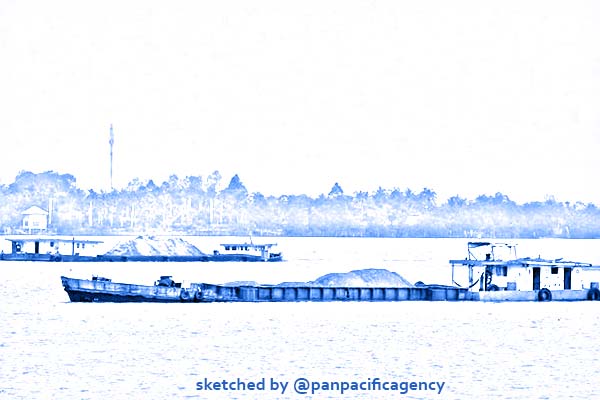[Analytics] What’s at stake in the Mekong’s dam-fueled decline

Mekong river. Photo by the VoA. Sketched by the Pan Pacific Agency.
In Cambodia, the end of the year marks the start of the traditional season for making prahok fish paste, a key part of the country’s diet. But Cambodia’s food supply—and that of the 70 million people who rely on the Mekong river—is at risk due to impacts from large hydropower dams and climate change, ASEAN Today reported.
Every year around December, fishers, farmers and families across Cambodia begin the season for making the country’s traditional prahok fish paste, a vital staple in the country’s diet. But this tradition, along with the food supply and livelihoods of millions of people, is under threat from a growing ecological crisis.
Recent reports show Cambodia’s Tonle Sap lake, the most productive freshwater fishery in the world, is in an increasingly stark decline with major social impacts.
Cambodia’s Ministry of Agriculture announced on December 23 that the freshwater fish catch among some of the country’s licensed fishers has dropped 31% compared to last year. Cambodia’s yearly fish catch is worth an estimated US$600 million.
The drop in fish catches, already echoed by many local residents, is caused by extremely low water levels—in the past 20 years, the lake’s average level has dropped by two meters. This drop is tied to both climate change and the construction of hydropower dams upstream on the Mekong river.
“We fishermen depend on water, fish and forests, so when these are gone, we can expect nothing—it’s over,” said Leng Vann, a local resident who lives about an hour by boat from Siem Reap, a recent report by AFP.
Tonle Sap lake is fed in large part by the Tonle Sap river, a unique tributary of the Mekong that reverses course twice per year. Flowing into the Mekong during the dry season, the Tonle Sap river normally changes direction around June when monsoon rains raise the levels of the Mekong, forcing water back up the river and swelling the lake to four times its size during dry season.
As the river flows backwards for around five months, it pushes an average of 38.37 cubic-kilometers of water into the lake every year. At its highest levels, Tonle Sap lake typically covers 14,500 square kilometers—an area over 13 times the size of Hong Kong.
But record low water levels mean this is no longer the case; water, nutrients, sediment and fish aren’t flowing into the Tonle Sap as they always have. In both 2019 and 2020, the Tonle Sap river reversed course months later than normal. In 2019, it only flowed into the lake for around six weeks.
These threats to the Tonle Sap—and to the 70 million people who rely on the Mekong basin—present the region’s governments with a choice: they can protect their citizens’ food supply and an irreplaceable ecosystem, or they can continue to build large, risky and unneeded hydropower dams.
Shrinking Tonle Sap puts food supplies at risk
Over a million people rely directly on Tonle Sap lake for their livelihoods, and many more depend on it for their food supply. Some sources say over 80% of Cambodia’s population relies on fish as their main source of protein, with the average Cambodian eating an estimated 50 kilograms of fish per year.
But the dropping levels of the lake are putting fish supplies at risk. According to Om Savath, the executive director for Fisheries Action Coalition Team, water levels have stagnated at a point far shallower than the depth needed for some kinds of fish to reach full maturity.
Historically, mangrove forests along the dry season boundaries of the lake have become flooded in the monsoon, providing vital areas for fishing and other local livelihoods. Over the past 10 years, the area of mangrove forests flooded during each rainy season has dropped from 634,000 hectares to about 300,000 hectares, according to local group Fisheries Action Coalition Team.
The Tonle Sap fishery is a major source of employment, as its fishing industry directly supports livelihoods for an estimated 2 million people or over 20% of Cambodia’s total labor force.
One fisherman in the Koh Chivang area, Sim Suom, told AFP that the decline in the fisheries is pushing young people to leave the area.
“Children from this community go to work in factories now because there are no fish in the lake,” said fisherman Sim Suom, 59, adding that his daughter now works in a cigarette factory in Siem Reap.
Solution lies in addressing large dams, climate change
Locals and environmental advocates point to the twin factors of climate change and hydropower dams upstream on the Mekong in driving the Tonle Sap’s crisis. According to some, the lake’s levels have been severely affected by two hydropower dams in Laos—the Xayaburi dam and the Don Sahong dam—which opened in 2019. Over half of the water in the Tonle Sap comes from the Mekong.
A growing body of evidence also shows dams on the upper Mekong in China are a key driver of dropping water levels. Research by both academics and the Mekong River Commission shows that the specific impacts of dams—from blocking sediment and nutrients to preventing migration—are causing the decline of the Mekong basin’s fisheries.
As Kheav Cheam, a fisherman on Tonle Sap lake, told Vice News recently, “We’re afraid that people living in the upper parts have closed the dam, so we are growing desperate. It’s getting worse and worse for fishing—in the future, there will be no fishing because there is no water left.”